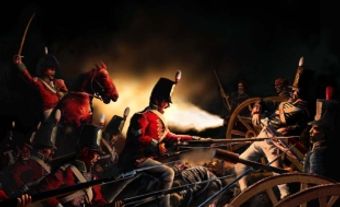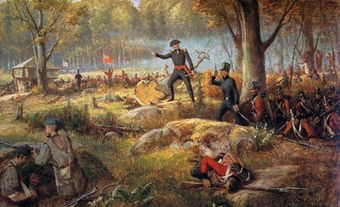Battle of Lundy's Lane National Historic Site of Canada
Battle of Lundy's Lane National Historic Site marks the 25 July 1814 Battle of Lundy's Lane, the fiercest and bloodiest land action during the War of 1812. At the height of the 5-hour-long battle, much of which was fought after dark, about 3000 British and Canadian soldiers faced some 2800 American invaders. In 1895, the federal government erected a 12-metre-high granite memorial monument in the Drummond Hill Cemetery, the centre of the battleground. Various plaques and smaller memorials are also on the site. The battleground received formal designation as a national historic site from the Historic Sites and Monuments Board of Canada in 1937.
The battle took place around the junction of Portage Road and Lundy's Lane, in what is now the city of Niagara Falls. From the 1820s to the 1860s, the battle site became a popular tourist destination, especially for Americans. Several observation towers were constructed which gave visitors an opportunity to have an overview of the area. In the years following the battle, the hill, where the heaviest fighting had taken place, became known as Drummond Hill, while the cemetery, which continued to be used and expanded, was named, accordingly, Drummond Hill Cemetery. Of related interest, the cemetery is the final resting place of War of 1812 notable Laura Secord.
A little community at the road junction evolved into a sizable village, which, in 1831, was officially christened Drummondville. It became part of the city of Niagara Falls in 1904. As a result of this urban growth, a large portion of the battle site is now covered with private homes and businesses as well as several schools and churches. Lundy's Lane itself, a narrow, dusty, tree-lined road in 1814, is now a 4-lane artery. The city does own and preserve a little more than 4 hectares of the battle site, including 1.5 hectares donated by Ruth Redmond in 1996. Redmond was a local high school teacher who lived in a small house on the battlefield and patiently purchased adjacent lots. The Redmond parcels across Lundy's Lane from the cemetery were converted into parkland, although one building (built circa 1831) is preserved and is now the home of the municipally owned Battle Ground Hotel Museum featuring many exhibits related to the battle.
Overview of the Battle of Lundy's Lane
Of great importance militarily and commercially, the Portage Road extended in a winding 13-km route between the small communities of Queenston (now part of Niagara-on-the-Lake) and Chippawa (now part of the city of Niagara Falls). Lundy's Lane ran west from the Portage Road to William Lundy's farm, with a section of it crossing over a high, sandy ridge, or hill. Because of the hill's elevation and easy digging, a cemetery was established on its top in 1799.
Around 7:00 pm on 25 July 1814, Lieutenant-General Gordon Drummond's force arrived at the junction from the north and set up a defensive position in the cemetery to halt a large American force approaching along Portage Road. In the battle that followed, the American force, commanded by Major-General Jacob Brown, captured the cemetery position. Drummond's forces fought to regain it, but did not succeed. Around midnight, both armies were exhausted, having fought each other to a standstill. The Americans retreated to their camp near Chippawa.
Casualties were heavy, with both sides losing more than 850 men killed, wounded or missing in action. Tactically, the battle of Lundy's Lane can be considered to have been a draw, since neither side had been defeated. Strategically, however, it was a British victory since the battle ended the Americans' Niagara offensive; by early November 1814, the Americans had retreated to the New York side of the Niagara River.

 Share on Facebook
Share on Facebook Share on X
Share on X Share by Email
Share by Email Share on Google Classroom
Share on Google Classroom


